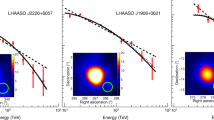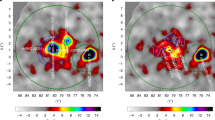Abstract
Galactic cosmic rays consist of protons, electrons and ions, most of which are believed to be accelerated to relativistic speeds in supernova remnants1,2,3. All components of the cosmic rays show an intensity that decreases as a power law with increasing energy (for example as E-2.7). Electrons in particular lose energy rapidly through synchrotron and inverse Compton processes, resulting in a relatively short lifetime (about 105 years) and a rapidly falling intensity, which raises the possibility of seeing the contribution from individual nearby sources (less than one kiloparsec away)4. Here we report an excess of galactic cosmic-ray electrons at energies of ∼300–800 GeV, which indicates a nearby source of energetic electrons. Such a source could be an unseen astrophysical object (such as a pulsar5 or micro-quasar6) that accelerates electrons to those energies, or the electrons could arise from the annihilation of dark matter particles (such as a Kaluza–Klein particle7 with a mass of about 620 GeV).
This is a preview of subscription content, access via your institution
Access options
Subscribe to this journal
Receive 51 print issues and online access
$199.00 per year
only $3.90 per issue
Buy this article
- Purchase on Springer Link
- Instant access to full article PDF
Prices may be subject to local taxes which are calculated during checkout




Similar content being viewed by others
References
Tang, K.-K. The energy spectrum of electrons and cosmic-ray confinement. A new measurement and its interpretation. Astrophys. J. 278, 881–892 (1984)
Allen, G. E. et al. Evidence of X-ray synchrotron emission from electrons accelerated to 40 TeV in the supernova remnant Cassiopeia A. Astrophys. J. 487, L97–L100 (1997)
Aharonian, F. A. et al. High-energy particle acceleration in the shell of a supernova remnant. Nature 432, 75–77 (2004)
Kobayashi, T. et al. The most likely sources of high-energy cosmic-ray electrons in supernova remnants. Astrophys. J. 601, 340–351 (2004)
Aharonian, F. A. et al. Cosmic ray positrons connected with galactic gamma radiation of high and very high energies. J. Phys. G Nucl. Part. Phys. 17, 1769–1778 (1991)
Heinz, S. & Sunyaev, R. Cosmic rays from microquasars: A narrow component in the CR spectrum. Astron. Astrophys. 390, 751–766 (2002)
Cheng, H. C., Feng, J. L. & Matchev, K. T. Kaluza–Klein dark matter. Phys. Rev. Lett. 89, 211301 (2002)
Nishimura, J. et al. in 25th ICR Conf. Papers Vol. 4 (eds Potgieter, M. S., Raubenheimer, B. C. & van der Walt, O. J.) 233–237 (Space Research Unit, Durban, 1997)
Nishimura, J. et al. Emulsion chamber observations of primary cosmic-ray electrons in the energy range 30–1000 GeV. Astrophys. J. 238, 394–409 (1980)
Guzik, T. G. et al. The ATIC long duration balloon project. Adv. Space Res. 33, 1763–1770 (2004)
Ganel, O. et al. Beam tests of the balloon-borne ATIC experiment. Nucl. Instrum. Methods A 552, 409–419 (2005)
Chang, J. et al. Resolving electrons from protons in ATIC. Adv. Space Res. 42, 431–436 (2008)
Chang, J. et al. in Proc. 28th Intl Cosmic Ray Conf. (eds Kajita, T., Asaoka, Y., Kawachi, A., Matsubara, Y. & Sasaki, M.) 1817–1820 (Universal Acad. Press, Tokyo, 2003)
Strong, A. W. & Moskalenko, I. V. Models for galactic cosmic-ray propagation. Adv. Space Res. 27, 717–726 (2001)
Li, T. P. & Ma, Y.-Q. Analysis methods for results in gamma-ray astronomy. Astrophys. J. 272, 317–324 (1983)
Torii, S. et al. High energy electron observation by Polar Patrol Balloon flight in Antarctica. Adv. Polar Upper Atmos. Res. 20, 52–62 (2006)
Aharonian, F. A. et al. Very high energy gamma rays from the composite SNR G 0.9+0.1. Astron. Astrophys. 432, L25–L29 (2005)
Büsching, I., de Jager, O. C., Potgieter, M. S. & Venter, C. A cosmic-ray positron anisotropy due to two middle-aged, nearby pulsars? Astrophys. J. 678, L39–L42 (2008)
Hooper, D. & Silk, J. Searching for dark matter with future cosmic positron experiments. Phys. Rev. D 71, 083503 (2005)
Applequist, T. & Yee, H.-U. Universal extra dimensions and the Higgs boson mass. Phys. Rev. D 67, 055002 (2003)
Moskalenko, I. V. & Strong, A. W. Galactic propagation of positrons from particle dark-matter annihilation. Phys. Rev. D 60, 063003 (1999)
Delahaye, T. et al. Positrons from dark matter annihilation in the galactic halo: Theoretical uncertainties. Phys. Rev. D 77, 063527 (2008)
Hooper, D. Indirect searches for dark matter. Preprint at 〈http://arXiv.org/abs/0710.2062v1〉 (2008)
Drees, M. & Gerbier, G. Supersymmetric dark matter. Phys. Lett. B 592, 216–219 (2004)
Servant, G. & Tait, T. M. P. Is the lightest Kaluza–Klein particle a viable dark matter candidate? Nucl. Phys. B 650, 391–419 (2003)
Hooper, D., Finkbeiner, D. P. & Dobler, G. Possible evidence for dark matter annihilation from excess microwave emission around the center of the Galaxy seen by the Wilkinson Microwave Anisotropy Probe. Phys. Rev. D 76, 083012 (2007)
Lavalle, J. et al. Full calculation of clumpiness boost factors for antimatter cosmic rays in the light of ΛCDM N-body simulation results: Abandoning hope in clumpiness enhancement? Astron. Astrophys. 479, 427–452 (2008)
Diemand, J. et al. Clumps and streams in the local dark matter distribution. Nature 454, 735–738 (2008)
Brun, P. et al. Antiproton and positron signal enhancement in dark matter minispikes scenarios. Phys. Rev. D 76, 083506 (2007)
Barwick, S. W. et al. Measurements of the cosmic-ray positron fraction from 1 to 50 GeV. Astrophys. J. 482, L191–L194 (1997)
Alcaraz, J. et al. Leptons in near Earth orbit. Phys. Lett. B 484, 10–22 (2000)
Torii, S. et al. The energy spectrum of cosmic-ray electrons from 10 to 100 GeV observed with a highly granulated imaging calorimeter. Astrophys. J. 559, 973–984 (2001)
Acknowledgements
This research was supported in the USA by NASA, in Russia by the Russian Foundation for Basic Research, and in China by the National Natural Science Foundation. The help of the NASA BPO and CSBF during balloon flights and the US NSF and RPSC for Antarctica operations is gratefully acknowledged.
Author Contributions Each institution in the ATIC collaboration assumed particular roles, each of which provided important contributions to this paper. In particular, the Max Planck Institute and Purple Mountain Observatory (PMO) developed the electron observation techniques. Marshall Space Flight Center (MSFC), Moscow State University (MSU) and Louisiana State University (LSU) developed the hardware which was integrated at LSU, who also led the flight team. The University of Maryland (UMD) and MSU performed instrument simulations and processed the data. PMO led the electron analysis of the flight data and LSU and PMO prepared the manuscript.
Author information
Authors and Affiliations
Corresponding author
Supplementary information
Supplementary Information
This file contains Supplementary Data, Supplementary Figures S1-S12 with Legends and Supplementary References (PDF 816 kb)
Rights and permissions
About this article
Cite this article
Chang, J., Adams, J., Ahn, H. et al. An excess of cosmic ray electrons at energies of 300–800 GeV. Nature 456, 362–365 (2008). https://doi.org/10.1038/nature07477
Received:
Accepted:
Issue Date:
DOI: https://doi.org/10.1038/nature07477
This article is cited by
-
STCF conceptual design report (Volume 1): Physics & detector
Frontiers of Physics (2024)
-
Signals of millicharged dark matter in light-shining-through-wall experiments
Journal of High Energy Physics (2023)
-
Neutrino forces and the Sommerfeld enhancement
Journal of High Energy Physics (2022)
-
Search for Higgs bosons decaying into new spin-0 or spin-1 particles in four-lepton final states with the ATLAS detector with 139 fb−1 of pp collision data at \( \sqrt{s} \) = 13 TeV
Journal of High Energy Physics (2022)
-
Advances in direct measurements of cosmic rays
Journal of the Korean Physical Society (2021)
Comments
By submitting a comment you agree to abide by our Terms and Community Guidelines. If you find something abusive or that does not comply with our terms or guidelines please flag it as inappropriate.



